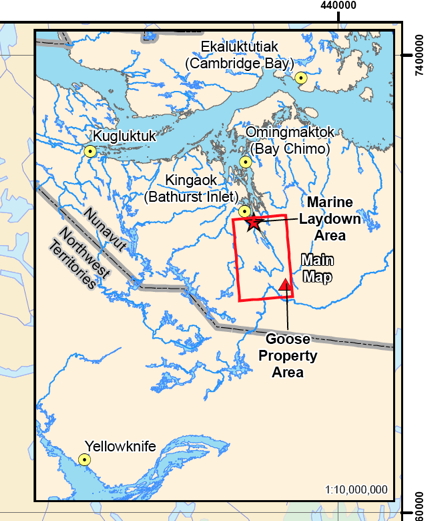Nunavut review board reverses course, approves Back River mine
It turns out that now is a good time to go ahead with Sabina’s Back River gold mine project.
After saying “no” to the multi-million dollar Kitikmeot project in June 2016, and being told by a federal minister that “no” was the wrong answer, the Nunavut Impact Review Board “has concluded that the Back River Gold Mine Project Proposal may proceed at this time.”
However, the NIRB says this was not a foregone conclusion.
“For those who may have expressed concern that the Board’s further consideration of the Project would be a ’rubber stamp’ only, and would not lead to any substantive improvements to the Project, the Board notes that the further consideration was conducted with the same care and thoroughness as the original assessment,” the NIRB said in a July 18 news release.

In a statement released by the company July 18, Sabina said it was “extremely pleased” with the NIRB’s positive recommendation.
“We are moving ever closer to our goal of becoming a mid-tier gold producer in one of the word’s best mining jurisdictions,” Sabina President and CEO Bruce McLeod said in the release.
Sabina must now await approval of the final report from Carolyn Bennett, minister of Indigenous and Northern Affairs Canada, and then a project certificate from the NIRB.
In the meantime, Sabina plans to submit water licence applications to the Nunavut Water Board to get the project rolling, their news release said.
The NIRB’s green light comes with 94 terms and conditions that the board hopes will ensure the mine “is developed, operated and reclaimed in a manner that would not unduly and adversely impact the ecosystemic integrity of the Nunavut Settlement Area.”
Those terms and conditions mostly address five key areas raised by Bennett in her January letter to the NIRB which scuttled the board’s original 347-page final hearing report and directed them to conduct a more robust review.
Those five areas include caribou and terrestrial wildlife along with freshwater and marine environments.
“The Board notes that Sabina’s revised plans now constitute some of the most protective caribou protection measures ever developed for the Arctic,” the NIRB says in its news release.
Part of those measures include preparing for the “possibility” of the project overlapping with caribou calving grounds even though the project, as currently proposed, does not overlap.
The NIRB also notes that Sabina’s enhanced monitoring plan, “greatly increases the Board’s confidence that Sabina would have the information necessary to respond rapidly if unpredicted, or greater than predicted, effects are identified.”
It was concern over those potential impacts on the land, water and animals that prompted the NIRB to conclude a year ago that now was not a good time to go forward with the Sabina Gold and Silver Corp. project, located about 400 km southwest of Cambridge Bay.
That conclusion came after four years of environmental screening, assessment and public hearings by the NIRB.
And while some agreed with the NIRB that Back River should be shelved for now, others didn’t.
Some lamented the loss of jobs and economic development, suggested project risks were not so high and that any impact on the dwindling Bathurst caribou herd and other wildlife could be managed if the company was given time to work on, and explain, its mitigation plans.
Bennett, in her letter to the NIRB requesting they have a closer look at the project, called the board’s initial findings “premature” and “deficient in respect to some ecosystemic issues.”
The minister’s letter led to concern from some groups—the NWT-based Yellowknives Dene First Nation, for example—that company lobbying of the federal government had undermined the review board’s authority and expertise.
Shortly after Bennett overruled the NIRB’s report, Sabina issued a public statement saying it was “extremely pleased” and that they were confident the NIRB would be satisfied with the company’s beefed up mitigation measures.
The NIRB then held fresh hearings this past May during which board members heard 1,500 new points from Sabina containing “significant new information” about the mine.
Sabina’s plans for Back River include a chain of open pit and underground mines at its Goose property.
The pits are expected to be operational for at least 10 years and would involve filling, damming or draining lakes and streams and building a 157-km road from the mine to a seasonal port and tank farm at Bathurst Inlet.
Sabina hoped to produce about 200,000 ounces of gold per year with an initial investment of $415 million.
News of the NIRB’s approval was good for the company. According to business news reports, Sabina Gold & Silver Corp. shares rose as much as seven per cent to a four-year high on July 19.
You can read the NIRB’s revised final hearing report, a record of comments and submissions and evidence presented on their NIRB’s website here and searching it’s public registry.